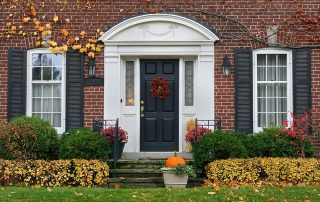I’m sorry to say it, but fall and winter are upon us again. There are some great elements to autumn, though. All the pumpkin spice addicts can come out of the wood work, Halloween and Thanksgiving are nearly back to back, and yard work finally starts coming to a close.
However, before you fully shut down for the winter, there are some last minute lawn maintenance tasks that can make a significant difference come next summer. All you’ll need is a lawn mower, rake, garden fork or aerator, and the number of your trusted lawn treatment service.
Keep it Clean and Cut
Typically, I tell people to stop mowing around Thanksgiving,” Randy Hazer co-owner of Team Turf, a premier fertilizer and lawn treatment service says. “You want it freshly cut for winter. If your yard goes into the winter high, you’re going to get more snow mold in the lawn come spring and the leaves will tie up into the grass.
Hazer is right, a layer of dead organic material can build up on the turf, locking in excess moisture, accelerating mold growth, and weaken the strength of your grass. To avoid snow mold and a mossy lawn, keep your grass short and rake leaves, “thatch,” and any other organic debris.
“For your last cut or two, you should lower the blade down to about two inches,” Hazer notes. Up until this point, it helps to keep you lawn closer to the 2 ½ to 3 inch mark for a healthier lawn.
Get Some Fresh Aeration
To both aerate and improve drainage in the yard, homeowners can use a garden/pitch fork or a push aerator to allow air and water to absorb into the root zone easier. If you’re using an electronic aerator, you may be tempted to rake up the soil cores/plugs, but make sure to leave them. Additionally, it can be helpful to mark areas in the lawn that should be avoided, such as places with shallow septic lines, irrigation lines, or sprinkler heads.
Aeration is also a great idea if you’re expecting to fertilize or seed your lawn. It’s frequently recommended that homeowners also spread horticulture sand into the holes to keep them open longer.
Lime Your Lawn
“Fall is the great time to lime your lawn,” Hazer asserts. If you live in rainy, humid area where plants thrive on higher soil PH levels, your yard will most likely benefit from a treatment. This is because most lawn grass grows best in PH level between 6 and 7.2, according to Penn State University’s Center for Turfgrass Science.
Feel Free to Seed
Especially after aeration, seeding your lawn in the early fall (September and/or Early October) is the optimal time, especially when planting cool-season grasses. “You really don’t want to seed in late October or November because it gets too cold,” Hazer says. The soil in autumn is just warm enough, there is still plenty of sunlight, and most times, there are less weeds for seeds to compete with than in the summer—and on the flipside, there isn’t frost to contend with.
If you miss your window of opportunity to seed in the fall, be sure to overseed come spring time.
Great Time to Fertilize
High-end lawn treatment companies will offer a winterizer treatment to prepare your lawn for the frosty months ahead. “We put down a combination of fertilizer: nitrogen, phosphorous, and potassium,” Hazer says of Team Turf’s fall services. “The grass stores nitrogen over the winter, it uses the phosphorous for root growth, and the potassium is for strengthening the turf.” The nitrogen also helps to accelerate how fast your lawn greens up the following spring. The use of lawn fertizer late in the year can really improve your lawn early the next.
Check for Grubs
Lawns start to green up as the oppressive heat of summer eases off for fall. However, if you have a grub problem, you’ll begin notices patches of your lawn that aren’t getting their color back. “If people have grubs right now they definitely want to treat them. They’ll continue to do damage and then you’ll have crows, black birds, skunks, and raccoons tearing up the lawn to feed on them,” says Hazer.
Hazer notes that a few grubs are okay, say if you’ve seen a couple while pulling up your garden for the winter. When you treat for grubs, you’re controlling a damaging population, not just a few healthy stragglers.
“If there are grubs, the lawn will be discolored, and the turf will just lift right up. If you see discoloration or if you see birds or skunks digging up an area you just want to go over and grab handfuls of the turf and just try to pull it up,” Hazer recommends. “You’ll see them under there.”
Finding about six to ten grubs per square foot is a sign of a problem. Be sure to take care of this before winter as the grubs will burrow deeper into the soil and will be more difficult to treat later.
Think about Lawn Care for Next Year
Now is the perfect time to start thinking about lawn care for next year. Find a local lawn service that knows the area and the treatment your lawn needs.
